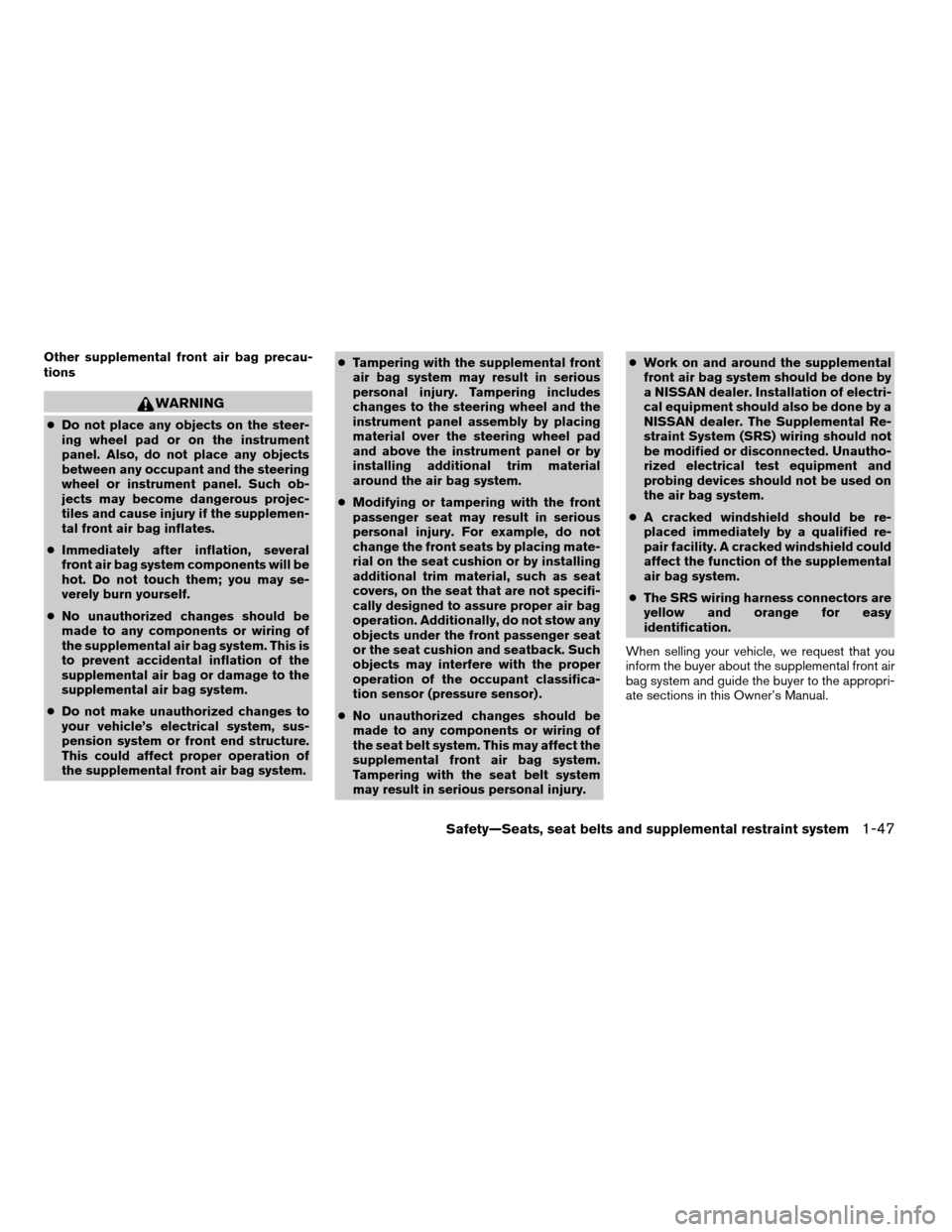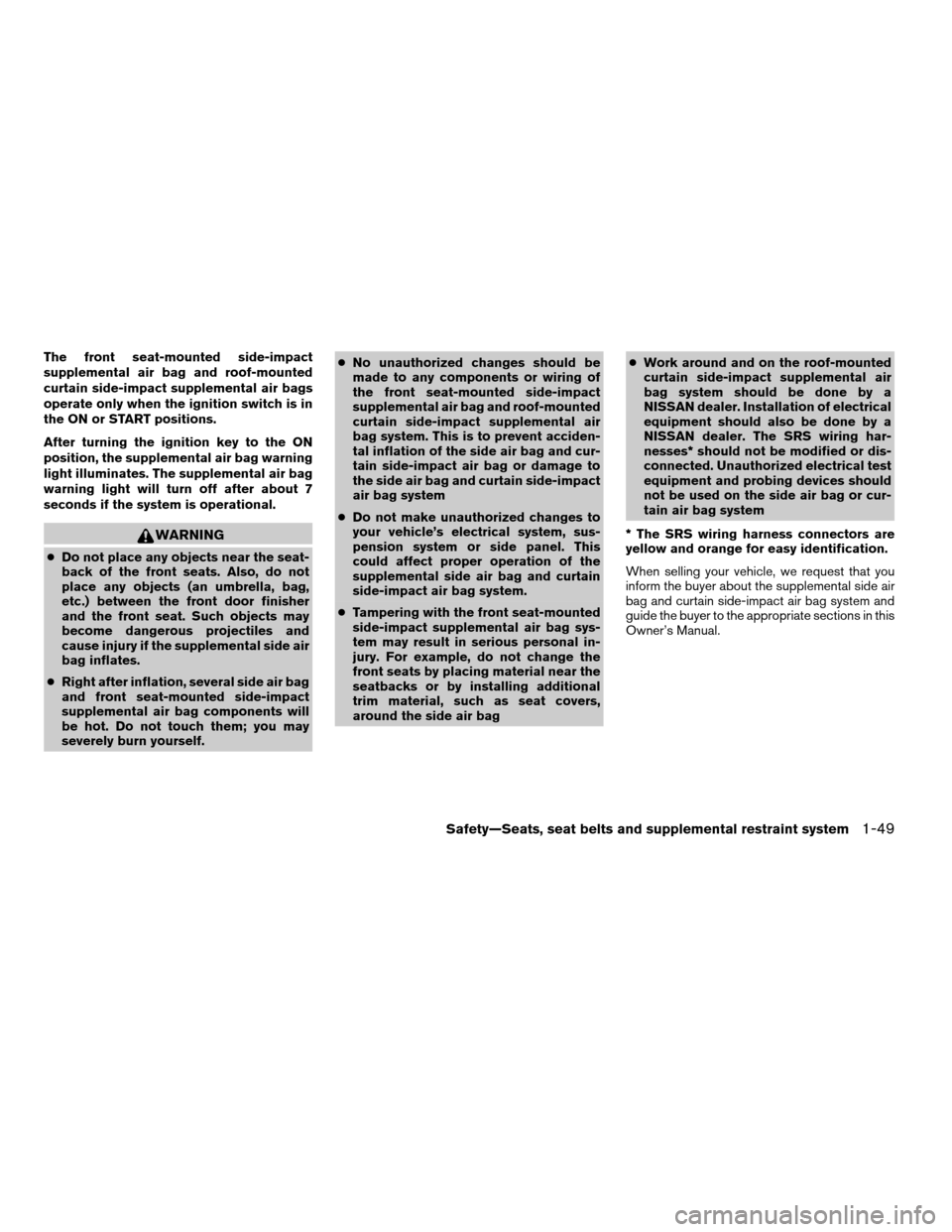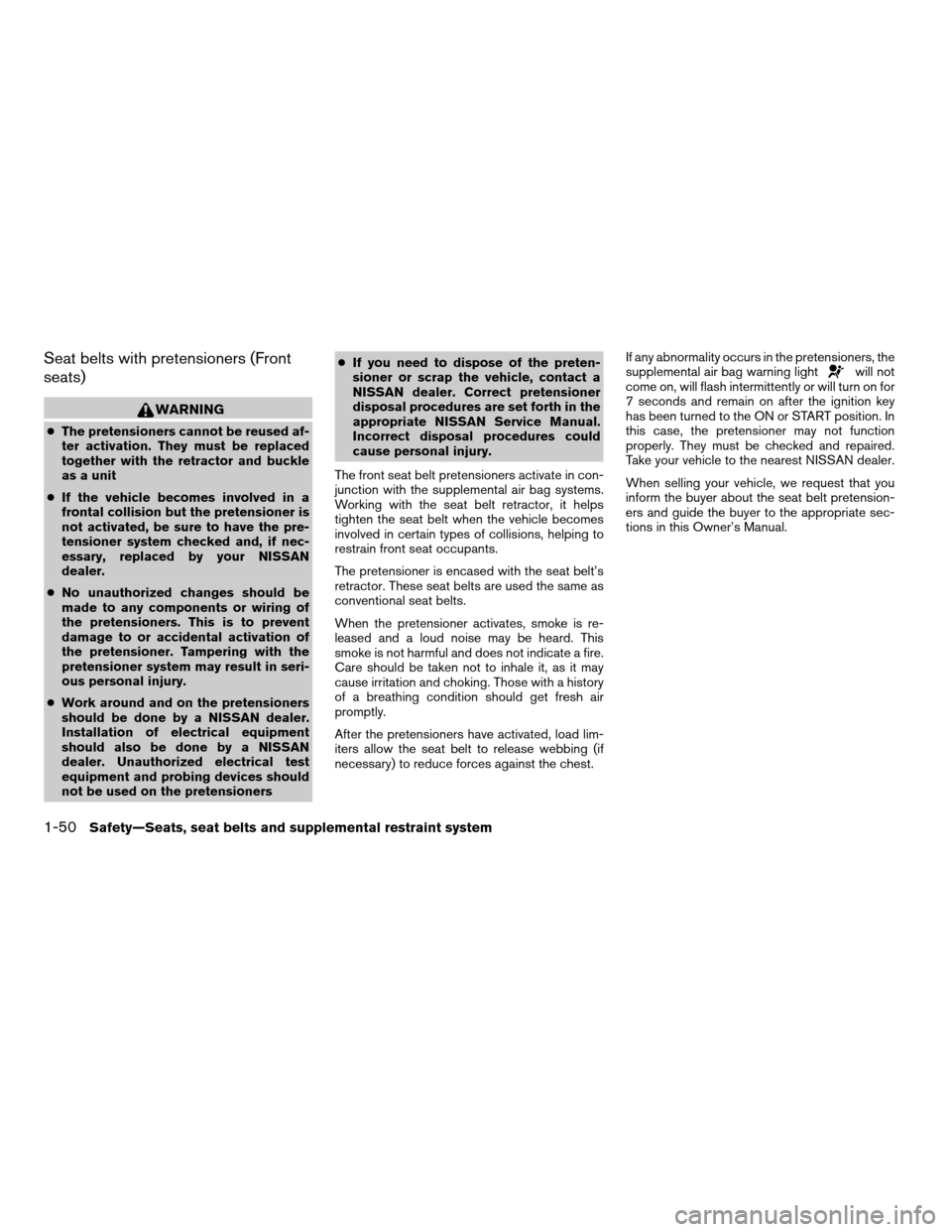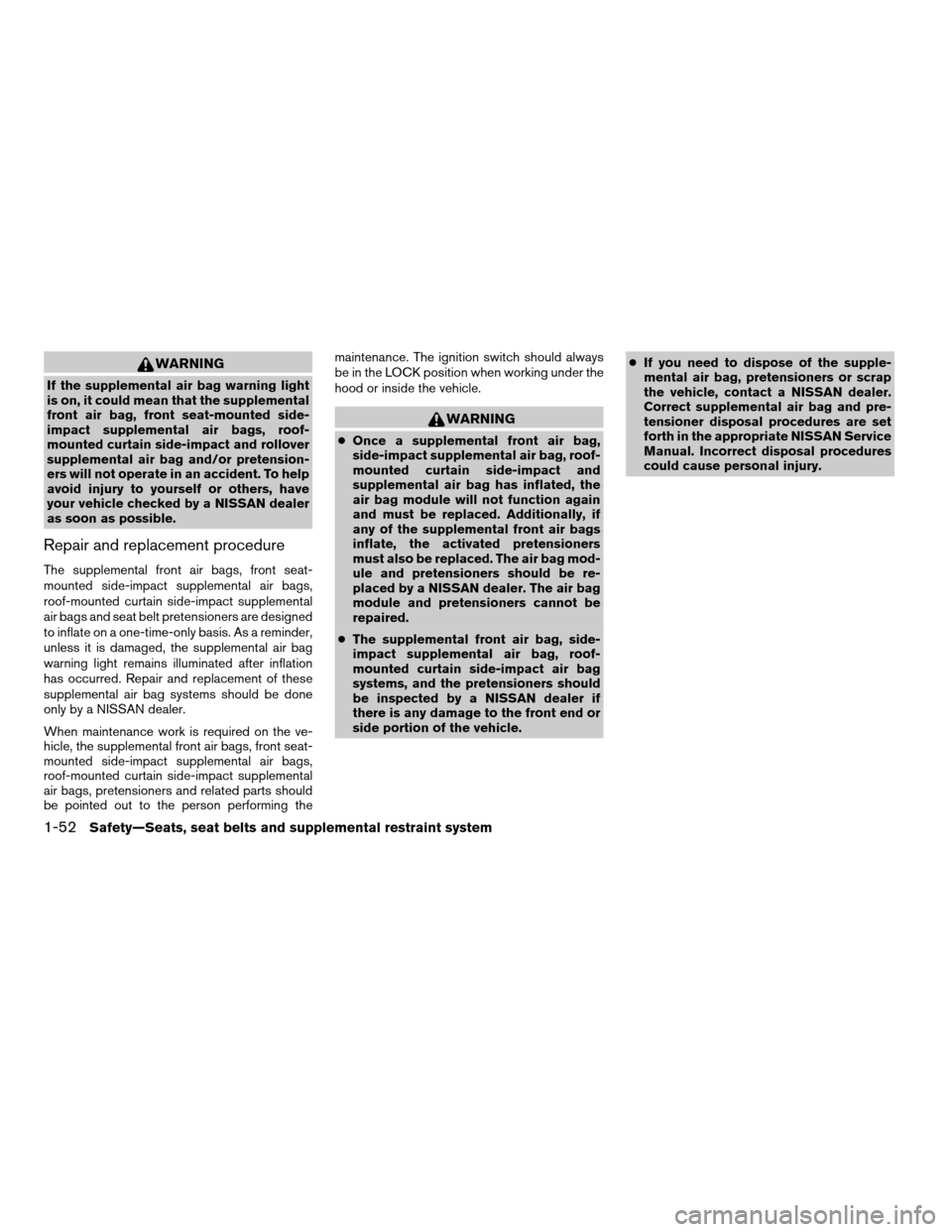NISSAN MAXIMA 2008 A34 / 6.G Repair Manual
Manufacturer: NISSAN, Model Year: 2008, Model line: MAXIMA, Model: NISSAN MAXIMA 2008 A34 / 6.GPages: 328, PDF Size: 4.17 MB
Page 61 of 328

Front passenger air bag status light
WARNING
The front passenger air bag is designed to
automatically turn OFF under some con-
ditions. Read this section carefully to
learn how it operates. Proper use of the
seat, seat belt and child restraints is nec-
essary for most effective protection. Fail-
ure to follow all instructions in this
manual concerning the use of seats, seat
belts and child restraints can increase the
risk or severity of injury in an accident.Status light
The front passenger air bag status light
is
located below the radio. The light operates as
follows:
cUnoccupied passenger’s seat: The
is
OFF and the front passenger air bag is OFF
and will not inflate in a crash.
cPassenger’s seat occupied by a small adult,
child or child restraint as outlined in this
section: The
illuminates to indicate
that the front passenger air bag is OFF and
will not inflate in a crash.
cOccupied passenger seat and the passen-
ger meets the conditions outlined in this
section: The light
is OFF to indicate
that the front passenger air bag is opera-
tional.
Front passenger air bag
The front passenger air bag is designed to auto-
matically turn OFF when the vehicle is operated
under some conditions as described below in
accordance with U.S. regulations. If the front
passenger air bag is OFF, it will not inflate in a
crash. The driver air bag and other air bags in your
vehicle are not part of this system.
The purpose of the regulation is to help reduce
the risk of injury or death from an inflating air bagto certain front passenger seat occupants, such
as children, by requiring the air bag to be auto-
matically turned OFF. Certain sensors are used
to meet the requirements.
One sensor used is the occupant classification
sensor (pressure sensor) . It is in the bottom of the
front passenger seat cushion and is designed to
detect an occupant and objects on the seat by
weight. It works together with seat belt sensors
described later. For example, if a child is in the
front passenger seat, the advanced air bag sys-
tem is designed to turn the passenger air bag
OFF in accordance with the regulations. Also, if a
child restraint of the type specified in the regula-
tions is on the seat, its weight and the child’s
weight can be detected and cause the air bag to
turn OFF. Occupant classification sensor opera-
tion can vary depending on the front passenger
seat belt sensors.
The front passenger seat belt sensors are de-
signed to detect if the seat belt is buckled and the
amount of tension on the seat belt, such as when
it is in the Automatic Locking Retractor mode
(child restraint mode) . Based on the weight on
the seat detected by the occupant classification
sensor and the belt tension detected on the seat
belt, the advanced air bag system determines
whether the front passenger air bag should be
automatically turned OFF as required by the
regulations.
LRS0316
Safety—Seats, seat belts and supplemental restraint system1-45
ZREVIEW COPYÐ2008 Maxima(max)
Owners ManualÐUSA_English(nna)
06/08/07Ðdebbie
X
Page 62 of 328

Front passenger seat adult occupants who are
properly seated and using the seat belt as out-
lined in this manual should not cause the passen-
ger air bag to be automatically turned OFF. For
small adults it may be turned OFF, however if the
occupant takes his/her weight off the seat cush-
ion (for example, by not sitting upright, by sitting
on an edge of the seat, or by otherwise being out
of position) , this could cause the sensor to turn
the air bag OFF. In addition, if the occupant
improperly uses the seat belt in the Automatic
Locking Retractor mode (child restraint mode) ,
this could cause the air bag to be turned OFF.
Always be sure to be seated and wearing the seat
belt properly for the most effective protection by
the seat belt and supplemental air bag.
NISSAN recommends that pre-teens and chil-
dren be properly restrained in a rear seat.
NISSAN also recommends that appropriate child
restraints and booster seats be properly installed
in a rear seat. If this is not possible, the occupant
classification sensor and seat belt sensors are
designed to operate as described above to turn
the front passenger air bag OFF for specified
child restraints as required by the regulations.
Failing to properly secure child restraints and to
use the Automatic Locking Retractor mode (child
restraint mode) may allow the restraint to tip or
move in an accident or sudden stop. This can also
result in the passenger air bag inflating in a crashinstead of being OFF. See “Child restraints” ear-
lier in this section for proper use and installation.
If the front passenger seat is not occupied the
passenger air bag is designed not to inflate in a
crash. However, heavy objects placed on the
seat could result in air bag inflation, because of
the object’s weight detected by the occupant
classification sensor. Other conditions could also
result in air bag inflation, such as if a child is
standing on the seat, or if two children are on the
seat, contrary to the instructions in this manual.
Always be sure that you and all vehicle occupants
are seated and restrained properly.
Using the passenger air bag status light, you can
monitor when the front passenger air bag is au-
tomatically turned OFF with the seat occupied.
The light will not illuminate when the front pas-
senger seat is unoccupied.
If an adult occupant is in the seat but the passen-
ger air bag status light is illuminated (indicating
that the air bag is OFF) , it could be that the
person is a small adult, or is not sitting on the seat
properly or not using the seat belt properly.
If a child restraint must be used in the front seat,
the passenger air bag status light may or may not
be illuminated, depending on the size of the child
and the type of child restraint being used. If the air
bag status light is not illuminated (indicating that
the air bag might inflate in a crash) , it could bethat the child restraint or seat belt is not being
used properly. Make sure that the child restraint is
installed properly, the seat belt is used properly
and the occupant is positioned properly. If the air
bag status light is not illuminated, reposition the
occupant or child restraint in a rear seat.
If the passenger air bag status light will not illu-
minate even though you believe that the child
restraint, the seat belts and the occupant are
properly positioned, the system may be sensing
an unoccupied seat (in which case the air bag is
OFF) . Your NISSAN dealer can check that the
system is OFF by using a special tool. However,
until you have confirmed with your dealer that
your air bag is working properly, reposition the
occupant or child restraint in a rear seat.
The air bag system and passenger air bag status
light will take a few seconds to register a change
in the passenger seat status. For example, if a
large adult who is sitting in the front passenger
seat exits the vehicle, the passenger air bag
status light will go from OFF to ON for a few
seconds and then to OFF. This is normal system
operation and does not indicate a malfunction.
If a malfunction occurs in the front passenger air
bag system, the supplemental air bag warning
light
, located in the meter and gauges area
in the center of the instrument panel, will blink.
Have the system checked by a NISSAN dealer.
1-46Safety—Seats, seat belts and supplemental restraint system
ZREVIEW COPYÐ2008 Maxima(max)
Owners ManualÐUSA_English(nna)
06/08/07Ðdebbie
X
Page 63 of 328

Other supplemental front air bag precau-
tions
WARNING
cDo not place any objects on the steer-
ing wheel pad or on the instrument
panel. Also, do not place any objects
between any occupant and the steering
wheel or instrument panel. Such ob-
jects may become dangerous projec-
tiles and cause injury if the supplemen-
tal front air bag inflates.
cImmediately after inflation, several
front air bag system components will be
hot. Do not touch them; you may se-
verely burn yourself.
cNo unauthorized changes should be
made to any components or wiring of
the supplemental air bag system. This is
to prevent accidental inflation of the
supplemental air bag or damage to the
supplemental air bag system.
cDo not make unauthorized changes to
your vehicle’s electrical system, sus-
pension system or front end structure.
This could affect proper operation of
the supplemental front air bag system.cTampering with the supplemental front
air bag system may result in serious
personal injury. Tampering includes
changes to the steering wheel and the
instrument panel assembly by placing
material over the steering wheel pad
and above the instrument panel or by
installing additional trim material
around the air bag system.
cModifying or tampering with the front
passenger seat may result in serious
personal injury. For example, do not
change the front seats by placing mate-
rial on the seat cushion or by installing
additional trim material, such as seat
covers, on the seat that are not specifi-
cally designed to assure proper air bag
operation. Additionally, do not stow any
objects under the front passenger seat
or the seat cushion and seatback. Such
objects may interfere with the proper
operation of the occupant classifica-
tion sensor (pressure sensor) .
cNo unauthorized changes should be
made to any components or wiring of
the seat belt system. This may affect the
supplemental front air bag system.
Tampering with the seat belt system
may result in serious personal injury.cWork on and around the supplemental
front air bag system should be done by
a NISSAN dealer. Installation of electri-
cal equipment should also be done by a
NISSAN dealer. The Supplemental Re-
straint System (SRS) wiring should not
be modified or disconnected. Unautho-
rized electrical test equipment and
probing devices should not be used on
the air bag system.
cA cracked windshield should be re-
placed immediately by a qualified re-
pair facility. A cracked windshield could
affect the function of the supplemental
air bag system.
cThe SRS wiring harness connectors are
yellow and orange for easy
identification.
When selling your vehicle, we request that you
inform the buyer about the supplemental front air
bag system and guide the buyer to the appropri-
ate sections in this Owner’s Manual.
Safety—Seats, seat belts and supplemental restraint system1-47
ZREVIEW COPYÐ2008 Maxima(max)
Owners ManualÐUSA_English(nna)
06/08/07Ðdebbie
X
Page 64 of 328

Front seat-mounted side-impact
supplemental air bag and roof-
mounted curtain side-impact
supplemental air bag system
The front seat-mounted side-impact supplemen-
tal air bags are located in the outside of the
seatback of the front seats. The roof-mounted
curtain side-impact supplemental air bags are
located in the side roof rails. These systems are
designed to meet voluntary guidelines to help
reduce the risk of injury to out-of-position occu-
pants.However, all of the information, cau-
tions and warnings in this manual still ap-
ply and must be followed.The front seat-mounted side-impact supplemental air bag and
roof-mounted curtain side-impact supplemental
air bags are designed to inflate in higher severity
side collisions, although they may inflate if the
forces in another type of collision are similar to
those of a higher severity side impact. They are
designed to inflate on the side where the vehicle
is impacted. They may not inflate in certain side
collisions.
Vehicle damage (or lack of it) is not always an
indication of proper front seat-mounted side-
impact supplemental air bag and roof-mounted
curtain side-impact supplemental air bag opera-
tion.
When the front seat-mounted side-impact
supplemental air bag and roof-mounted curtain
side-impact supplemental air bags inflate, a fairly
loud noise may be heard, followed by release of
smoke. This smoke is not harmful and does not
indicate a fire. Care should be taken not to inhale
it, as it may cause irritation and choking. Those
with a history of a breathing condition should get
fresh air promptly.
The front seat-mounted side-impact supplemen-
tal air bag, along with the use of seat belts, help to
cushion the impact force on the chest and pelvic
area of the front occupants. Roof-mounted cur-
tain side-impact supplemental air bags help to
cushion the impact force to the head of occu-pants in the front and rear outboard seating po-
sitions. They can help save lives and reduce
serious injuries. However, inflating front seat-
mounted side-impact supplemental air bag and
roof-mounted curtain side-impact supplemental
air bags may cause abrasions or other injuries.
Front seat-mounted side-impact supplemental
air bag and roof-mounted curtain side-impact
supplemental air bags do not provide restraint to
the lower body.
The seat belts should be correctly worn and the
driver and passenger seated upright as far as
practical away from the front seat-mounted side-
impact supplemental air bag. Rear seat passen-
gers should be seated as far away as practical
from the door finishers and side roof rails. The
front seat-mounted side-impact supplemental air
bag and roof-mounted curtain side-impact
supplemental air bags inflate quickly in order to
help protect the front occupants. Because of this,
the force of the side air bag and curtain side-
impact air bag inflating can increase the risk of
injury if the occupant is too close to, or is against,
these air bag modules during inflation. The front
seat-mounted side-impact supplemental air bag
and roof-mounted curtain side-impact supple-
mental air bags will deflate quickly after the colli-
sion is over.
LRS0259
1-48Safety—Seats, seat belts and supplemental restraint system
ZREVIEW COPYÐ2008 Maxima(max)
Owners ManualÐUSA_English(nna)
06/08/07Ðdebbie
X
Page 65 of 328

The front seat-mounted side-impact
supplemental air bag and roof-mounted
curtain side-impact supplemental air bags
operate only when the ignition switch is in
the ON or START positions.
After turning the ignition key to the ON
position, the supplemental air bag warning
light illuminates. The supplemental air bag
warning light will turn off after about 7
seconds if the system is operational.
WARNING
cDo not place any objects near the seat-
back of the front seats. Also, do not
place any objects (an umbrella, bag,
etc.) between the front door finisher
and the front seat. Such objects may
become dangerous projectiles and
cause injury if the supplemental side air
bag inflates.
cRight after inflation, several side air bag
and front seat-mounted side-impact
supplemental air bag components will
be hot. Do not touch them; you may
severely burn yourself.cNo unauthorized changes should be
made to any components or wiring of
the front seat-mounted side-impact
supplemental air bag and roof-mounted
curtain side-impact supplemental air
bag system. This is to prevent acciden-
tal inflation of the side air bag and cur-
tain side-impact air bag or damage to
the side air bag and curtain side-impact
air bag system
cDo not make unauthorized changes to
your vehicle’s electrical system, sus-
pension system or side panel. This
could affect proper operation of the
supplemental side air bag and curtain
side-impact air bag system.
cTampering with the front seat-mounted
side-impact supplemental air bag sys-
tem may result in serious personal in-
jury. For example, do not change the
front seats by placing material near the
seatbacks or by installing additional
trim material, such as seat covers,
around the side air bagcWork around and on the roof-mounted
curtain side-impact supplemental air
bag system should be done by a
NISSAN dealer. Installation of electrical
equipment should also be done by a
NISSAN dealer. The SRS wiring har-
nesses* should not be modified or dis-
connected. Unauthorized electrical test
equipment and probing devices should
not be used on the side air bag or cur-
tain air bag system
* The SRS wiring harness connectors are
yellow and orange for easy identification.
When selling your vehicle, we request that you
inform the buyer about the supplemental side air
bag and curtain side-impact air bag system and
guide the buyer to the appropriate sections in this
Owner’s Manual.
Safety—Seats, seat belts and supplemental restraint system1-49
ZREVIEW COPYÐ2008 Maxima(max)
Owners ManualÐUSA_English(nna)
06/08/07Ðdebbie
X
Page 66 of 328

Seat belts with pretensioners (Front
seats)
WARNING
cThe pretensioners cannot be reused af-
ter activation. They must be replaced
together with the retractor and buckle
as a unit
cIf the vehicle becomes involved in a
frontal collision but the pretensioner is
not activated, be sure to have the pre-
tensioner system checked and, if nec-
essary, replaced by your NISSAN
dealer.
cNo unauthorized changes should be
made to any components or wiring of
the pretensioners. This is to prevent
damage to or accidental activation of
the pretensioner. Tampering with the
pretensioner system may result in seri-
ous personal injury.
cWork around and on the pretensioners
should be done by a NISSAN dealer.
Installation of electrical equipment
should also be done by a NISSAN
dealer. Unauthorized electrical test
equipment and probing devices should
not be used on the pretensionerscIf you need to dispose of the preten-
sioner or scrap the vehicle, contact a
NISSAN dealer. Correct pretensioner
disposal procedures are set forth in the
appropriate NISSAN Service Manual.
Incorrect disposal procedures could
cause personal injury.
The front seat belt pretensioners activate in con-
junction with the supplemental air bag systems.
Working with the seat belt retractor, it helps
tighten the seat belt when the vehicle becomes
involved in certain types of collisions, helping to
restrain front seat occupants.
The pretensioner is encased with the seat belt’s
retractor. These seat belts are used the same as
conventional seat belts.
When the pretensioner activates, smoke is re-
leased and a loud noise may be heard. This
smoke is not harmful and does not indicate a fire.
Care should be taken not to inhale it, as it may
cause irritation and choking. Those with a history
of a breathing condition should get fresh air
promptly.
After the pretensioners have activated, load lim-
iters allow the seat belt to release webbing (if
necessary) to reduce forces against the chest.If any abnormality occurs in the pretensioners, the
supplemental air bag warning light
will not
come on, will flash intermittently or will turn on for
7 seconds and remain on after the ignition key
has been turned to the ON or START position. In
this case, the pretensioner may not function
properly. They must be checked and repaired.
Take your vehicle to the nearest NISSAN dealer.
When selling your vehicle, we request that you
inform the buyer about the seat belt pretension-
ers and guide the buyer to the appropriate sec-
tions in this Owner’s Manual.
1-50Safety—Seats, seat belts and supplemental restraint system
ZREVIEW COPYÐ2008 Maxima(max)
Owners ManualÐUSA_English(nna)
06/08/07Ðdebbie
X
Page 67 of 328

1. SRS Air Bag Warning Labels (located
on the sun visors)
2. Front seat-mounted side-impact
supplemental air bags Warning Labels
(located on the door pillar)
SUPPLEMENTAL AIR BAG
WARNING LABELS
Warning labels about the supplemental front air
bag, supplemental side air bag and curtain side-
impact air bag systems are placed in the vehicle
as shown in the illustration.
SUPPLEMENTAL AIR BAG
WARNING LIGHT
The supplemental air bag warning light,
displayingin the instrument panel, moni-
tors the circuits of the supplemental front air bag,
front seat-mounted side-impact supplemental air
bag, roof-mounted curtain side-impact supple-
mental air bag and seat belt pretensioner system.
The circuits monitored by the supplemental air
bag warning light are the Air bag Control Unit
(ACU) , crash zone sensor, satellite sensors, front
seat-mounted side-impact supplemental air bag
modules, side air bag modules, roof-mountedcurtain side-impact supplemental air bag mod-
ules, seat belt pretensioners and all related wir-
ing.
When the ignition key is in the ON or START
position, the supplemental air bag warning light
illuminates for about 7 seconds and then turns
off. This means the system is operational.
If any of the following conditions occur, the
supplemental front air bag, side-impact supple-
mental air bag, roof-mounted curtain side-impact
supplemental air bag and pretensioner systems
need servicing:
cThe supplemental air bag warning light re-
mains on after approximately 7 seconds.
cThe supplemental air bag warning light
flashes intermittently.
cThe supplemental air bag warning light does
not come on at all.
Under these conditions, the supplemental front
air bag, side-impact supplemental air bags, roof-
mounted curtain side-impact supplemental air
bags or pretensioners may not operate properly.
It must be checked and repaired. Take your ve-
hicle to the nearest NISSAN dealer.
WRS0169LRS0100
Safety—Seats, seat belts and supplemental restraint system1-51
ZREVIEW COPYÐ2008 Maxima(max)
Owners ManualÐUSA_English(nna)
06/08/07Ðdebbie
X
Page 68 of 328

WARNING
If the supplemental air bag warning light
is on, it could mean that the supplemental
front air bag, front seat-mounted side-
impact supplemental air bags, roof-
mounted curtain side-impact and rollover
supplemental air bag and/or pretension-
ers will not operate in an accident. To help
avoid injury to yourself or others, have
your vehicle checked by a NISSAN dealer
as soon as possible.
Repair and replacement procedure
The supplemental front air bags, front seat-
mounted side-impact supplemental air bags,
roof-mounted curtain side-impact supplemental
air bags and seat belt pretensioners are designed
to inflate on a one-time-only basis. As a reminder,
unless it is damaged, the supplemental air bag
warning light remains illuminated after inflation
has occurred. Repair and replacement of these
supplemental air bag systems should be done
only by a NISSAN dealer.
When maintenance work is required on the ve-
hicle, the supplemental front air bags, front seat-
mounted side-impact supplemental air bags,
roof-mounted curtain side-impact supplemental
air bags, pretensioners and related parts should
be pointed out to the person performing themaintenance. The ignition switch should always
be in the LOCK position when working under the
hood or inside the vehicle.
WARNING
cOnce a supplemental front air bag,
side-impact supplemental air bag, roof-
mounted curtain side-impact and
supplemental air bag has inflated, the
air bag module will not function again
and must be replaced. Additionally, if
any of the supplemental front air bags
inflate, the activated pretensioners
must also be replaced. The air bag mod-
ule and pretensioners should be re-
placed by a NISSAN dealer. The air bag
module and pretensioners cannot be
repaired.
cThe supplemental front air bag, side-
impact supplemental air bag, roof-
mounted curtain side-impact air bag
systems, and the pretensioners should
be inspected by a NISSAN dealer if
there is any damage to the front end or
side portion of the vehicle.cIf you need to dispose of the supple-
mental air bag, pretensioners or scrap
the vehicle, contact a NISSAN dealer.
Correct supplemental air bag and pre-
tensioner disposal procedures are set
forth in the appropriate NISSAN Service
Manual. Incorrect disposal procedures
could cause personal injury.
1-52Safety—Seats, seat belts and supplemental restraint system
ZREVIEW COPYÐ2008 Maxima(max)
Owners ManualÐUSA_English(nna)
06/08/07Ðdebbie
X
Page 69 of 328

Safety—Seats, seat belts and supplemental restraint system1-53
MEMO
Page 70 of 328

2 Instruments and controls
Instrument panel...................................2-2
Meters and gauges................................2-3
Speedometer and odometer.....................2-4
Tachometer....................................2-5
Engine coolant temperature gauge...............2-5
Fuel gauge....................................2-6
Compass display (if so equipped)...................2-6
Zone variation change procedure.................2-8
Warning/indicator lights and audible reminders......2-10
Checking bulbs...............................2-10
Warning lights................................2-11
Indicator lights................................2-14
Audible reminders.............................2-17
Security systems.................................2-17
Vehicle security system.........................2-17
NISSAN vehicle immobilizer system.............2-19
Windshield wiper and washer switch...............2-20
Switch operation..............................2-20
Rear window and outside mirror (if so equipped)
defroster switch..................................2-21
Headlight and turn signal switch....................2-22
Xenon headlights (if so equipped)...............2-22
Headlight control switch........................2-23Daytime running light system (Canada only)......2-25
Instrument brightness control...................2-26
Turn signal switch.............................2-26
Fog light switch...............................2-26
Cornering light................................2-27
Hazard warning flasher switch.....................2-27
Horn............................................2-28
Heated seats (if so equipped)......................2-28
Heated steering wheel (if so equipped).............2-29
Traction Control System (TCS) off switch
(if so equipped)..................................2-29
Vehicle Dynamic Control (VDC) off switch
(if so equipped)..................................2-30
Rear sonar system off switch (if so equipped)........2-30
Power outlet.....................................2-31
Storage.........................................2-32
Map pockets..................................2-32
Seatback pockets.............................2-32
Sunglasses holder.............................2-32
Cup holders..................................2-33
Glove box....................................2-34
Console box..................................2-34
Covered storage box...........................2-35
ZREVIEW COPYÐ2008 Maxima(max)
Owners ManualÐUSA_English(nna)
06/08/07Ðdebbie
X